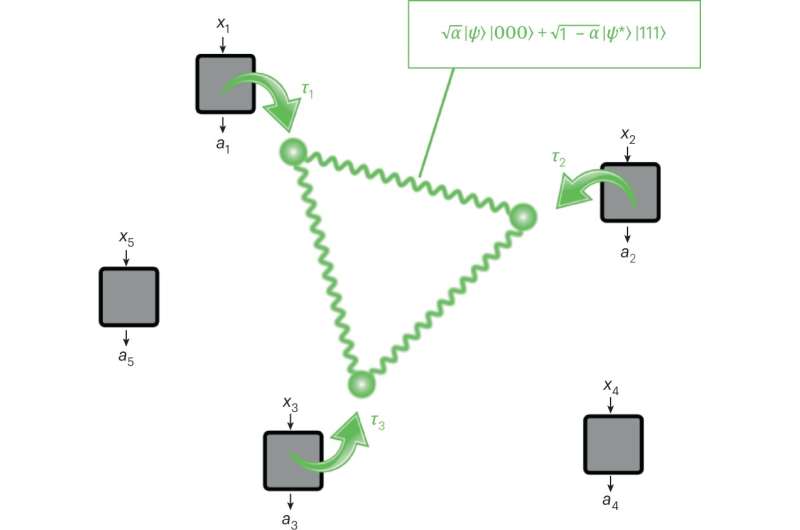
Self-testing is a promising method to infer the physics underlying specific quantum experiments using only collected measurements. While this method can be used to examine bipartite pure entangled states, so far it could only be applied to limited kinds of quantum states involving an arbitrary number of systems.
Researchers at Sorbonne University, ICFO-Institute of Photonic Sciences and Quantinuum recently introduced a framework for the quantum network-assisted self-testing of all pure entangled states of an arbitrary number of systems. Their paper, published in Nature Physics, could inform future research efforts aimed at certifying quantum phenomena.
“I was a postdoctoral researcher in Barcelona in 2014 in the group of Antonio Acín when the first author, Ivan Šupić and I began working on self-testing quantum states together,” Matty Hoban, one of the researchers who carried out the study, told Phys.org. “That is, certifying that you have systems in particular quantum states without trusting the devices and treating them as black boxes (called the device-independent setting). Part of this work involved exploring different kinds of scenarios of trust.”
During their initial collaboration, Hoban and Šupić investigated scenarios in which quantum physicists trust some of their experimental components and distrust others. Their goal was to then identify strategies that could simplify the certification of quantum states in these different scenarios.
“I had already moved back to the U.K. and was at the University of Oxford when Ivan visited me and we started exploring a setting where you could prepare particular, simple quantum states and trust this preparation, and then use these states to probe larger systems with more complex quantum states,” Hoban said. “This is a bit like using a small magnet (e.g., a compass) to characterize the magnetic field of the Earth. With the other authors Antonio Acín and Laia Domingo Colomer, we showed how you could self-test arbitrary quantum states in a setting called the Measurement-Device-Independent setting. Meanwhile Ivan was working with Joseph Bowles and Antonio Acín and Daniel Cavalcanti on the detection of entanglement in this completely black-box setting.”
In their new studies, Hoban and his colleagues found that the self-testing of simple quantum states could be a building block for the detection of entanglement. Specifically, this could be achieved by self-testing the maximally entangled state and transferring it in a networked scenario with more systems.
Combining their research efforts, the researchers were able to remove the assumption of characterized quantum state preparation in the measurement-device-independent setting outlined in one of their previous works. They then also teamed up with Marc-Olivier Renou, who was experienced in the study of device-independent quantum systems in networked scenarios.
“In traditional self-testing, if you want to certify that N parties have a particular N-partite quantum state, you would just ask questions of N devices,” Hoban explained. “But now imagine you had a large network of M devices and they can share information, and M could be larger than N. Network-assisted self-testing allows you to ask questions of this larger network to determine the behavior of a smaller number of devices. In the classical world adding additional devices might not seem to add anything: if I ask one person what time it is, their watch shouldn’t depend on whether they had a friend with them or not. But adding quantum systems can add something more.”
A significant difference between quantum systems and classical systems lays in the connections between different systems, particularly in the concept of quantum entanglement. Quantum entanglement underpins many quantum information tasks, such as quantum teleportation.
“If we have two parties, Alice can send an arbitrary unknown quantum state to Bob if they initially share a maximally entangled state,” Hoban said. “So not only entanglement, but maximal entanglement, allows us to move quantum information around from party to party. Instead of just Alice and Bob we can have multiple parties moving this information around, in a network.”
The network-assisted self-testing strategy introduced by Hoban and his colleagues exploits the fact that devices can be entangled with other devices to implement features of quantum theory, including teleportation. As part of their study, the researchers showed that their strategy successfully enables the self-testing of arbitrary pure quantum states.
“On a more foundational level, our results show that you can treat a system as a complete black box, yet from the statistics from interacting with it, you can conclude what the properties of the system are,” Hoban said. “It’s a bit like when you ask a witness to a crime to reconstruct what the alleged criminal looks like; the resulting image can look hilariously wrong or be completely generic. Furthermore, the witness could be lying and you would not know. In our work, you can perform a perfect reconstruction of the quantum description of a system just through asking questions to a black box and you could catch the system out if it tries to lie about what’s inside.”
The recent work by this team of researchers could soon open new opportunities for the certifying quantum devices and entangled quantum states. Notably, their proposed technique is generic, so it could be used to self-test a wide range of quantum states without requiring particular adaptations. Hoban and his colleagues are now working on making their strategy increasingly applicable to real-world problems.
“Our results are more proof-of-principle and require that you achieve some task perfectly; we need to allow for the possibility of some small error,” Hoban added. “This is called robust self-testing in the literature. Also, the methods we used are generic, and we would like to adapt them to particular settings to reduce the resource requirements. I would also like to find applications in delegating quantum computation and quantum cryptography.”
More information: Ivan Šupić et al, Quantum networks self-test all entangled states, Nature Physics (2023). DOI: 10.1038/s41567-023-01945-4
Journal information: Nature Physics

